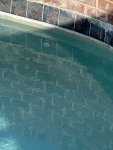Hey guys, I could use some advice about winterizing my pool here in north central Maryland.
I've read several pool winterization techniques online and watched a few You Tube videos. This weekend I started the process by ensuring it was balanced and hitting it with non-chlorine shock. Then I began draining the pool down to about 4" below the skimmer and started to blow out the skimmer lines. I'm a little confused about whether or not I need to drain the water below the return jets. A few of the videos mention draining 6 inches below the returns. My pool has fairly tall tiles and the jets are easily 12" below the water line, 6" below the jets will probably remove at least 1/3 of the pool water. Is this normal? Also, the previous owner left behind a bag of plugs, but I'm confused why I need to plug the holes if I have to drain it that low. Lastly, I'm not excited about installing the plugs as they can't be reached without getting INTO the pool.
See pic below. Ignore the scale it was actually much worse when we bought the house back in June and I've been slowly working on the issues.
thanks
I've read several pool winterization techniques online and watched a few You Tube videos. This weekend I started the process by ensuring it was balanced and hitting it with non-chlorine shock. Then I began draining the pool down to about 4" below the skimmer and started to blow out the skimmer lines. I'm a little confused about whether or not I need to drain the water below the return jets. A few of the videos mention draining 6 inches below the returns. My pool has fairly tall tiles and the jets are easily 12" below the water line, 6" below the jets will probably remove at least 1/3 of the pool water. Is this normal? Also, the previous owner left behind a bag of plugs, but I'm confused why I need to plug the holes if I have to drain it that low. Lastly, I'm not excited about installing the plugs as they can't be reached without getting INTO the pool.
See pic below. Ignore the scale it was actually much worse when we bought the house back in June and I've been slowly working on the issues.
thanks



